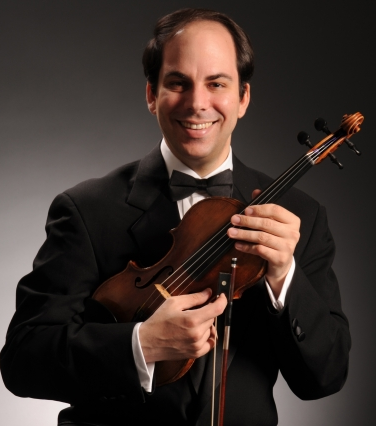Dan Auerbach in Review
Dan Auerbach, solo violin
The West End Presbyterian Church; New York, NY
October 14, 2017
The violinist Dan Auerbach presented an evening of unaccompanied works for the violin in a concert that was unconventional in almost every aspect of programming. In the modest, but acoustically sound main chapel of The West End Presbyterian Church, the tripartite recital was given without an intermission, and with barely a break between a succession of meaty, challenging works, both technically and interpretively.
Mr. Auerbach’s playing shows a abundance of both intellect and facility. It cannot be easy to start any program with the Bach D minor Partita, and even harder to play it as well as he did. Overall, his phrasing was lucid, fluid, his tone solid but never harsh, and his intonation secure, even in the most difficult double and triple stops. The Allemande was propulsive, declamatory, almost conversational, followed by a Courante that was feathery light, accurate but simply rendered. As in the first two movements, the dynamic range of the Sarabande and Gigue tended judiciously toward the soft, a welcome choice that drew the listener in rather than a more presentational approach. Mr. Auerbach ended with a beautiful account of the great Chaconne, especially strong in the outer minor sections. It is difficult to find the right tone after the modulation to D major, and I don’t think Mr. Auerbach ever settled into a convincing interpretation here, but his transition back into minor was finessed elegantly. This was a very satisfying performance.
After the briefest of bows and a bit of drying off with a handkerchief, the violinist launched into the Hudba for Solo Violin, Op. 9b, by the Czech composer Alois Hába. As a preface to this piece, Mr. Auerbach spoke of the composer’s work with microtonal music, and specifically the use of quarter tones in the Hudba. Right away, from the opening Allegro, the violinist made a great case for this overlooked composer. With a more boisterous, aggressive style of playing, he drew long, arching phrases. The Andante movement, alternately lyrical and heated, ended poetically, with a long, sensitively played decrescendo. By now, the ear was accustomed to smaller intervals, and I realized that, as a compositional tool, microtonality can be employed for more nuanced, detailed expression, much the same as our own human voices. Mr. Auerbach layered his playing of the Scherzo and final Moderato movement with a quiet control of murmuring tremolos, lightning fast scales, and difficult passages in the alpine regions of the instrument. Again, this was a completely convincing reading of an impressive composition.
With barely a moment to recover and readjust his ear to Western tonality, the violinist tore into the first of three selected Paganini Caprices, Op.1, No. 14. This Caprice, with its preponderance of multiple stops, is a challenge under any circumstances. After having played the Hába though, it became even more of a hurdle. Mr. Auerbach handled it well, though he did retune immediately after. He should give himself more of a break in the future. Caprice No. 5, however, needed no such disclaimers. It was simply virtuosity of the highest order, with a fluidity and security that is rarely seen. By this time, Mr. Auerbach may have regretted leaving No. 11, the hardest, for his finale. He gave a creditable account, and was rewarded with warm applause from the audience.
It is a pleasure and a relief to encounter artists such as Mr. Auerbach. He is a gifted, serious musician who places the integrity of the music and the composer first. I see from his biography that he is a devoted teacher, and I can only say that it gives me hope for the next generation of violinists.

